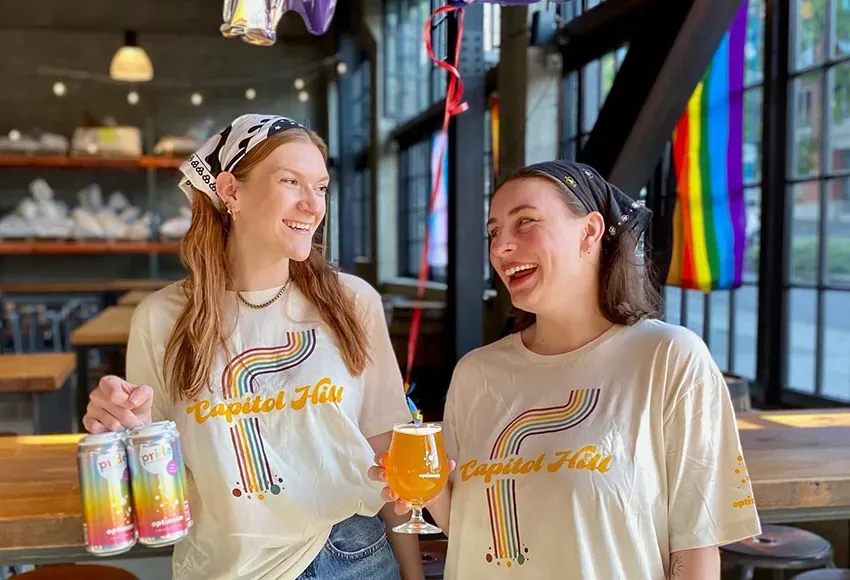It's the buzz of urbanist groups across the country: our "third places," where people from all walks of life gather to socialize, are disappearing. They have been for over a decade, and the COVID-19 pandemic only made the trend worse.
The definition of a third place differs slightly depending on where you look, but at its core, it's a relaxed, familiar spot separate from the workplace and the home. Think of bars, parks, cafés, barber shops, and churches. What holds them together is that they're accessible, accommodating to all, and on neutral ground, meaning that social status is often dropped and people generally aren't obligated to be there.
A 2019 paper published in the journal Health & Place sought to examine how a lack of accessible third places might impact public health. It used that year's polar vortex in the Midwest as an example, pointing to the many libraries, churches, and community centers that served as vital emergency warming centers, and the local businesses that donated food.
It also showed that the number of public and private establishments commonly considered third places sharply declined between 2008 and 2015, with little indication of changing course.
Only libraries and archives saw a healthy increase of 14%, which is good. Meanwhile "eateries" like bars, cafés, and restaurants increased slightly, by just 2%, but that was long before the pandemic; according to data from the Bureau of Labor Statistics, in 2020, restaurants and bars closed at almost double the normal rate.
A glance at 2021's closures might make it seem like the industry pulled out of its tailspin, but many of the surviving businesses are now weighed down by considerable debt.
The Queer community of Seattle has lost spaces like the Comeback, Re-Bar, OutWest, and others. Still more struggle to get by: the Wildrose, one of the oldest and few remaining Lesbian bars in the US, has nearly closed multiple times.
The Seattle Times and Capitol Hill Blog have already sounded the alarm on this issue, particularly as it pertains to Capitol Hill. Back in 2014, they reported on Amin Ghaziani's book There Goes the Gayborhood?, which cited US Census data that measured the number of same-sex couples in various neighborhoods of Seattle. They found that since 2000, the proportion of same-sex couples in Capitol Hill fell from 5% to 1.5%.
There are some limits to the census numbers. They don't measure Queer singles, or Bi/Pan people in different-sex couples. But in every neighborhood other than Capitol Hill, the percentage of same-sex couple households went up, implying that those in Seattle's Queer community who could afford it have spread out – or at least that Queer people who move to Seattle choose less often to live on Capitol Hill.
Ghaziani's book gives a few possible reasons for these trends. It could be that more widespread acceptance of Queer people lessened the demand for Queer-centric districts, though the spike in hate crimes in King County last year could be taken as a powerful contradiction of that idea.
A more concrete reason would be rises in rent and the general cost of living. By many measures, Seattle is one of the most expensive cities in the country.
That's a big problem for a large portion of the Queer people already here. Despite the stereotype of the affluent Gay couple, the 2021 Public Health – Seattle and King County Pride survey found that 20% of LGBTQ people living in the area earned less than $15,000, and 15% earned between $15,000 and $30,000. That's not even close to the amount one would need to live comfortably, let alone spend a night out every week.
On a brighter note, Capitol Hill is still a hub of Queer culture in the city in many ways – because geographically, it's still in the city's center, and its history draws people there. Places like Optimism Brewing Company host a number of Queer hobbyist groups, like the Queer Mountaineers. And I'd be remiss not to mention Queer-friendly game shops, like RayGun Lounge and Phoenix Comics and Games.
In areas without easy access to light rail, like Delridge and White Center, Queer culture has concentrated around venues like the recently restored Lumber Yard bar and the Southgate Roller Rink.
Going over the numbers might seem all doom and gloom, but in reality, the subject of third places in the modern day remains understudied, and doesn't come up in policymaking very often per se. And as cities go, Seattle is one of the best for its systems of public parks and libraries.
As new zoning laws are proposed and the Queer community becomes more spread out across King County, these numbers might serve as a reminder that we can have a role in nurturing existing third places and cultivating more, whether they're exclusively Queer or not. That takes advocacy, participation in local politics, and an awareness and appreciation of what makes these places so special.


